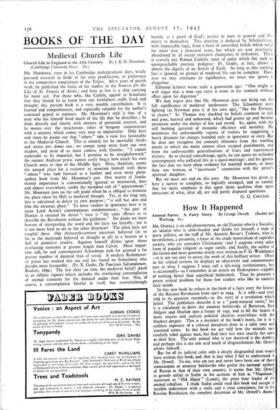BOOKS OF THE DAY
Medieval Church Life
Church Life in England in the 13th Century. By J. R. H. Moorman. (Cambridge University Press. 25s.) MR. MOORMAN, even in his Cambridge undergraduate days, wisely pursued research in fields of his own predilection, in preference to the competitive temptations of the Tripos. After years of parish work, he published the fruits of his studies in the Sources for the Life of _St. Francis of Assisi ; and here at last is a ship carrying far more sail. For those who, like Carlyle, appeal to historians that they should let us know how our forefathers really lived and thought, this present book is a very notable contribution. It is learned and comprehensive, and especially valuable for the author's continual appeal to statistics. Mr. Moorman's style is that of a man who has himself lived much of the life that he describes ; he deals directly and clearly with matters of perennial interest, and he moves over the treacherous ashes of byegone controversies with a serenity which comes very near to impartiality. Only here and there he points out that " others " take a view less favourable to the Medieval Church. This is natural, for he inevitably thinks and writes pro domo sua ; we cannot jump away from our own shadow, and most of us must confess with Goethe: " I cannot undertake to be impartial, but I promise to be straightforward." An earnest Anglican priest cannot easily fowl how much his own Church owes to that of the Middle Ages. Here, therefore, seems the natural place for a reviewer to associate himself with those " others " who look forward to a further and even more plain- spoken book from Mr. Moorman's pen. One matter of funda- mental importance is conventionally ignored or minimised, here and almost everywhere, under the mistaken cult of " appeasement." Mr. Moorman puts on the soft pedal when he is obliged to mention the place taken by Hell in medieval thought. Yet, in the long run, this is calculated to defeat its own purpose ; " it will but skin and film the ulcerous place." To leave readers in ignorance here is to incur Lord Acton's contemptuous condemnation " the part of Hamlet is omitted by desire "; here is " the same offence as to describe the Revolution without the guillotine." No doubt we must beware of interpreting the word and the facts too literally ; yet is it not more fatal to err in the other direction? The plain facts are roughly these. Our thirteenth-century ancestors believed (in so far as the multitude believed or thought at all) in a heaven or a hell of primitive crudity. Aquinas himself dilates upon those everlasting torments at greater length than Calvin. More impor- tant still, he and contemporary Schoolmen took for granted a far greater number of damned than of saved. A modern Redemptor- ist priest has worked this out and has found no Schoolman who decides more favourably. (Fr. X. Godts, De Paucitate Salvandorum. Routers, 1899.) The few elect (so runs the medieval belief) dwell in an infinite rapture which includes the everlasting contemplation of eternal torments for the damned under their feet. Not, of course, a contemplation blissful in itself, but overwhelmingly beatific as a proof of God's justice to man in general and His mercy to themselves. This doctrine is -deduced by Scholasticism, with impeccable logic, from a basis of unverified beliefs which ruled for more than a thousand years, but which are now practically abandoned by all except extremist champions of orthodoxy. There is scarcely any Roman Catholic tenet of today which has such an unimpeachable patristic pedigree: Fr. Godts, in fact, allows it almost the dignity of an Article of Faith. So long as this startling fact is ignored, no picture of medieval life can be complete. How- ever we may attenuate its significance, we must not ignore it altogether.
Edmond. Scherer wrote truly a generation ago: " One might as well argue that a man can carry a stone in his stomach without effect upon his digestion."
We may regret also that Mr. Moorman does not bring out the full significance of medieval intolerance. The Schoolmen were fighting (as Newman puts it of his own age), " like the Persians, in chains." St. Thomas was shackled by beliefs common to rich and poor, learned and unlearned, which had grown up and become inveterate under the shelter of fire and sword. So, again, with the still burning question of monastic efficiency and morality. He minimises the unfavourable reports of visitors by suggesting a heavy discount for charges founded only in ignorance or envy. But he does not recognise the contrary inference from the startling extent to which the worst sinners often escaped punishment, and from the unfavourable generalisations of friars and experienced visitors. As to clerical concubinage, again, he can quote no orthodox contemporary who palliated this as a quasi-marriage ; and he ignores the fact that we have often evidence for married women, or more than one woman, or " incestuous " connection with the priest's spiritual daughier.
But we must not end on this note. Mr. Moorman has given us here a survey so complete, so logically arranged, and so candid. that far more emphasis is due upon those qualities than upon omissions of what, after all, are still partly disputed questions.
G. G. COULTON.


























 Previous page
Previous page